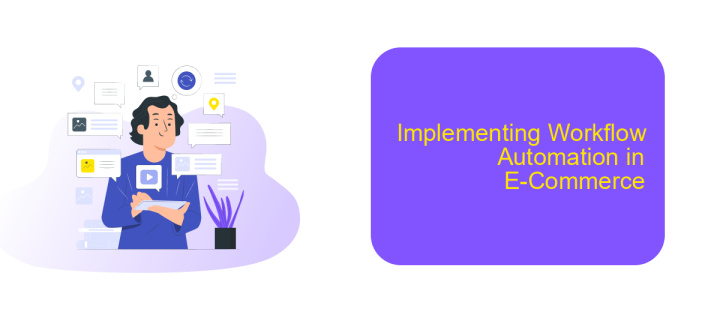Workflow Automation in E Commerce
Workflow automation in e-commerce is revolutionizing how businesses operate by streamlining processes, reducing manual tasks, and enhancing efficiency. By implementing automated systems, companies can improve order processing, inventory management, and customer service, leading to increased productivity and profitability. This article explores the benefits, tools, and strategies for effectively integrating workflow automation into your e-commerce operations.
Introduction
In the rapidly evolving world of e-commerce, businesses are constantly seeking ways to enhance efficiency and streamline operations. Workflow automation has emerged as a powerful solution to address these needs, enabling companies to automate repetitive tasks, reduce human error, and improve overall productivity. By integrating various systems and processes, businesses can create a seamless workflow that not only saves time but also enhances customer experience.
- Automates repetitive tasks
- Reduces human error
- Improves overall productivity
- Enhances customer experience
One of the key tools for achieving workflow automation in e-commerce is ApiX-Drive. This service allows businesses to easily integrate different applications and services without the need for extensive coding knowledge. By leveraging ApiX-Drive, companies can automate data transfer between platforms, manage customer interactions more effectively, and ensure that all systems are working in harmony. As a result, businesses can focus more on strategic growth and less on administrative tasks.
Benefits of Workflow Automation in E-Commerce

Workflow automation in e-commerce offers numerous advantages, significantly enhancing operational efficiency and reducing manual errors. By automating repetitive tasks such as order processing, inventory management, and customer service, businesses can save valuable time and resources. This allows employees to focus on more strategic activities, ultimately driving growth and improving overall productivity. Additionally, automation helps ensure consistency and accuracy in operations, leading to higher customer satisfaction and loyalty.
Moreover, integrating various e-commerce platforms and tools can be seamlessly managed through services like ApiX-Drive. This service enables businesses to connect different systems without requiring extensive technical knowledge, facilitating smoother data flow and communication between platforms. ApiX-Drive's user-friendly interface and robust functionality make it an ideal solution for streamlining workflows and enhancing the overall efficiency of e-commerce operations. By leveraging such automation tools, businesses can stay competitive in the fast-paced digital marketplace.
Types of Automated Workflows in E-Commerce

Automating workflows in e-commerce can significantly enhance efficiency and reduce manual labor. By implementing automated processes, businesses can streamline operations and focus on growth. Here are some common types of automated workflows in e-commerce:
- Order Processing: Automatically process orders from the moment they are placed to the point of shipping, reducing errors and speeding up fulfillment.
- Inventory Management: Keep track of stock levels in real-time, automatically reorder products when they run low, and update product listings across multiple platforms.
- Customer Relationship Management (CRM): Automate customer interactions, such as sending personalized emails, managing customer inquiries, and tracking customer behavior.
- Marketing Campaigns: Schedule and execute marketing campaigns, including email marketing, social media posts, and targeted advertisements, without manual intervention.
- Data Integration: Use services like ApiX-Drive to seamlessly integrate various e-commerce platforms and tools, ensuring data consistency and reducing the need for manual data entry.
By leveraging these automated workflows, e-commerce businesses can improve accuracy, save time, and provide a better overall customer experience. Tools like ApiX-Drive can be instrumental in connecting different systems and automating complex processes, making it easier to manage and scale operations.
Implementing Workflow Automation in E-Commerce

Implementing workflow automation in e-commerce can significantly enhance operational efficiency and reduce manual errors. The first step involves identifying repetitive tasks that can be automated, such as order processing, inventory management, and customer support. By automating these tasks, businesses can focus on more strategic activities that drive growth.
Next, selecting the right tools and software is crucial. Platforms like ApiX-Drive offer seamless integration with various e-commerce systems, allowing businesses to automate workflows without extensive technical expertise. ApiX-Drive supports integrations with popular platforms like Shopify, WooCommerce, and Magento, making it easier to synchronize data across different systems.
- Identify repetitive tasks for automation
- Select appropriate automation tools and software
- Integrate systems using platforms like ApiX-Drive
- Monitor and optimize automated workflows regularly
Finally, it's essential to continuously monitor and optimize automated workflows. Regularly reviewing performance metrics can help identify bottlenecks and areas for improvement. By leveraging workflow automation, e-commerce businesses can achieve higher efficiency, better customer satisfaction, and ultimately, increased profitability.
Best Practices for Workflow Automation in E-Commerce
Implementing workflow automation in e-commerce requires a strategic approach to ensure efficiency and scalability. Start by mapping out your existing processes to identify repetitive tasks that can be automated. Prioritize tasks that consume significant time and resources but offer minimal value when performed manually. Utilize tools like ApiX-Drive to seamlessly integrate various applications and services, enabling smooth data flow and reducing manual intervention. Ensure that your automation solutions are flexible and scalable to adapt to the evolving needs of your business.
Regularly monitor and evaluate the performance of your automated workflows to identify areas for improvement. Set clear metrics to measure the success of your automation efforts, such as time saved, error reduction, and increased productivity. Engage your team in the automation process by providing adequate training and support to ensure they can effectively manage and optimize automated workflows. Continuously update and refine your automation strategies to keep up with technological advancements and changing market demands, ensuring your e-commerce operations remain competitive and efficient.
FAQ
What is workflow automation in e-commerce?
How can workflow automation benefit my e-commerce business?
What are some common tasks that can be automated in e-commerce?
How do I get started with workflow automation for my e-commerce store?
Is it difficult to implement workflow automation in my existing e-commerce setup?
Time is the most valuable resource in today's business realities. By eliminating the routine from work processes, you will get more opportunities to implement the most daring plans and ideas. Choose – you can continue to waste time, money and nerves on inefficient solutions, or you can use ApiX-Drive, automating work processes and achieving results with minimal investment of money, effort and human resources.

